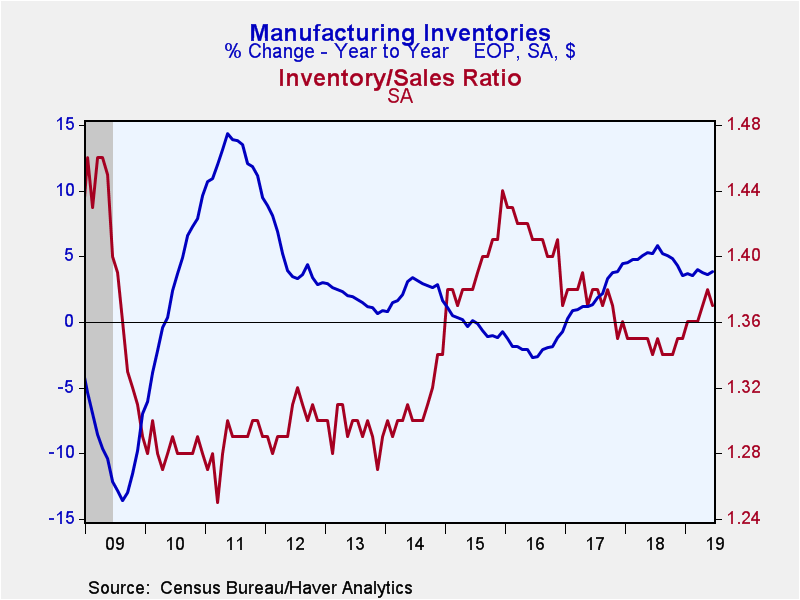 Global| Aug 15 2019
Global| Aug 15 2019U.S. Business Inventories Flat and Sales Edge Up in June
by:Sandy Batten
|in:Economy in Brief
Summary
Total business inventories were unchanged m/m (+5.2% y/y) in June versus an unrevised 0.3% m/m increase in June and a 0.5% m/m gain in April. Total business sales edged up 0.1% m/m (1.3% y/y) in June following a downwardly revised [...]
Total business inventories were unchanged m/m (+5.2% y/y) in June versus an unrevised 0.3% m/m increase in June and a 0.5% m/m gain in April. Total business sales edged up 0.1% m/m (1.3% y/y) in June following a downwardly revised 0.1% m/m decline in May (originally +0.2%). The inventory-to-sales (I/S) ratio slipped to 1.39 in June from an upwardly revised 1.40 in May. Business inventory swings can have a meaningful impact on GDP growth. In 2019 Q1 inventories added 0.5%-point to overall GDP growth but in Q2, they subtracted 0.9%-point. For all of Q2, inventories were up 0.8% q/q, a slowdown from the 1.2% q/q increase in Q1. Sales, however, picked up a bit in Q2, rising 0.6% q/q versus a 0.2% q/q gain in Q1.
Retail inventories declined 0.3% m/m (+4.2% y/y) in June, their first decline in three months. Auto inventories were a major contributor to the monthly decline; they fell 0.5% m/m. Inventories of furniture and home furnishings provided the biggest drag on the total in June as they fell 0.9% m/m. Clothing inventories also fell in June, declining 0.5% m/m. In contrast, general merchandise store inventories increased 0.3% m/m in June. Wholesale inventories were unchanged in June from May while manufacturing inventories rose 0.2% m/m.
Retail sales increased 0.3% (3.2% y/y) in June and in a separate report released today added another 0.7% m/m in July. Sales excluding autos also advanced 0.3% m/m (3.2% y/y) in June and jumped up 1.0% m/m in July. Wholesale sector sales slumped 0.3% m/m(-0.2% y/y) in June, their third consecutive monthly decline, while shipments from the factory sector rose 0.4% m/m (1.0% y/y) in June.
The inventory-to-sales ratio in the retail sector edged down to 1.45 in June from 1.46. The non-auto I/S ratio also edged down to 1.19 in June from 1.20 and stands just 0.01 above its all-time low of 1.18 reached in November 2018 (data go back to 1967). The wholesale I/S ratio was unchanged at 1.36 in June while the manufacturing I/S/ ratio slipped to 1.37 from 1.38, its first decline in 10 months.
After an extended period of time in which y/y sales growth outpaced y/y inventory growth, inventory growth has exceeded sales growth over the past eight months as sales growth has slowed. This could simply be inventories catching up but it could be the beginning of an inventory overhang that bears watching. Stay tuned for further installments.
The manufacturing and trade data are in Haver's USECON database.
| Manufacturing & Trade | Jun | May | Apr | Jun Y/Y | 2018 | 2017 | 2016 |
|---|---|---|---|---|---|---|---|
| Business Inventories (% chg) | 0.0 | 0.3 | 0.5 | 5.2 | 4.9 | 3.4 | 1.7 |
| Retail | -0.3 | 0.3 | 0.6 | 4.2 | 4.2 | 2.4 | 4.0 |
| Retail excl. Motor Vehicles | -0.1 | 0.2 | 0.5 | 2.8 | 1.7 | 2.0 | 2.0 |
| Merchant Wholesalers | 0.0 | 0.4 | 0.8 | 7.6 | 7.1 | 3.3 | 1.9 |
| Manufacturing | 0.2 | 0.2 | 0.2 | 3.9 | 3.5 | 4.5 | -0.7 |
| Business Sales (% chg) | |||||||
| Total | 0.1 | -0.1 | -0.2 | 1.3 | 6.1 | 5.4 | -0.8 |
| Retail | 0.3 | 0.4 | 0.3 | 3.2 | 4.6 | 4.5 | 2.4 |
| Retail excl. Motor Vehicles | 0.3 | 0.4 | 0.5 | 3.2 | 5.3 | 4.8 | 1.9 |
| Merchant Wholesalers | -0.3 | -0.6 | -0.4 | -0.2 | 6.5 | 6.7 | -1.3 |
| Manufacturing | 0.4 | 0.1 | -0.6 | 1.0 | 6.9 | 5.0 | -3.2 |
| I/S Ratio | |||||||
| Total | 1.39 | 1.40 | 1.39 | 1.34 | 1.36 | 1.38 | 1.42 |
| Retail | 1.45 | 1.46 | 1.46 | 1.44 | 1.45 | 1.47 | 1.49 |
| Retail excl. Motor Vehicles | 1.19 | 1.20 | 1.20 | 1.20 | 1.20 | 1.24 | 1.28 |
| Merchant Wholesalers | 1.36 | 1.36 | 1.34 | 1.26 | 1.29 | 1.30 | 1.35 |
| Manufacturing | 1.37 | 1.38 | 1.37 | 1.34 | 1.35 | 1.37 | 1.41 |
Sandy Batten
AuthorMore in Author Profile »Sandy Batten has more than 30 years of experience analyzing industrial economies and financial markets and a wide range of experience across the financial services sector, government, and academia. Before joining Haver Analytics, Sandy was a Vice President and Senior Economist at Citibank; Senior Credit Market Analyst at CDC Investment Management, Managing Director at Bear Stearns, and Executive Director at JPMorgan. In 2008, Sandy was named the most accurate US forecaster by the National Association for Business Economics. He is a member of the New York Forecasters Club, NABE, and the American Economic Association. Prior to his time in the financial services sector, Sandy was a Research Officer at the Federal Reserve Bank of St. Louis, Senior Staff Economist on the President’s Council of Economic Advisors, Deputy Assistant Secretary for Economic Policy at the US Treasury, and Economist at the International Monetary Fund. Sandy has taught economics at St. Louis University, Denison University, and Muskingun College. He has published numerous peer-reviewed articles in a wide range of academic publications. He has a B.A. in economics from the University of Richmond and a M.A. and Ph.D. in economics from The Ohio State University.










